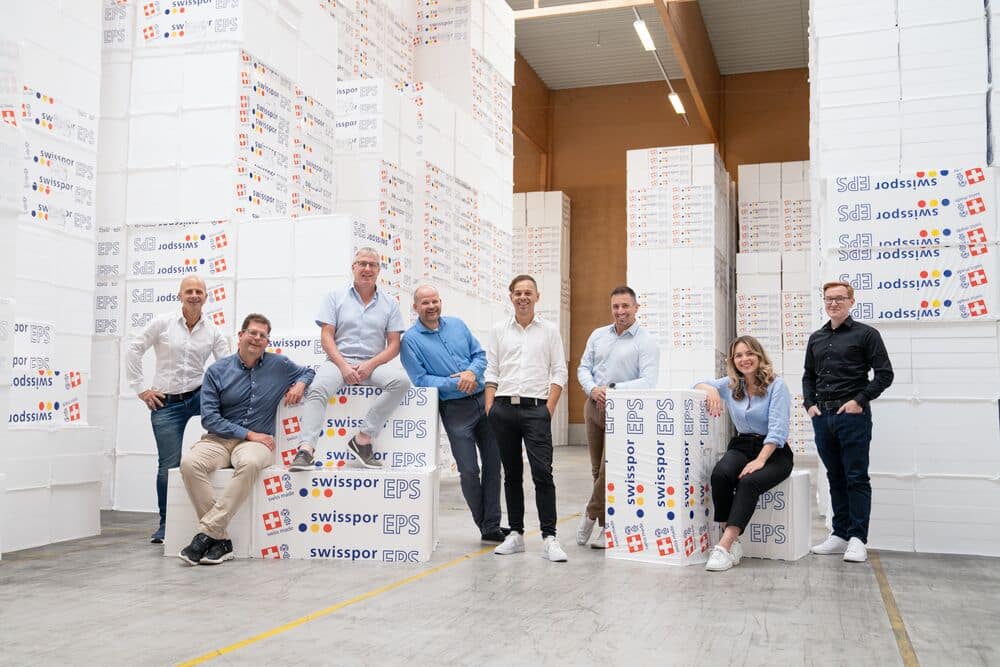
swisspor XPS Warehouse in Boswil
Starting Point: “We Didn’t Know Who Did What, or How”
The Solution: Subtle Change with a Clear Focus on Accountability
Instead of pursuing radical change, swisspor chose an organic, problem-driven approach. No buzzwords, no BPMN training sessions — just practical solutions to real issues using a tool that makes processes easy to understand.
“We never talked about ADONIS or BPMN. We just focused on solving problems in logistics, product management, and master data maintenance,” says Patrice Urban.
ADONIS wasn’t presented to employees as just another piece of software, but as a practical tool to get work done. Processes were visualised together in live workshops, where Patrice led the sessions and captured workflows directly in the tool, turning discussions into immediate, visible results.
“People didn’t have to prepare anything. I modelled live while they reflected, and suddenly there was a picture everyone could relate to,” says Patrice Urban.

swisspor EPS Production Site in Steinhausen
ADONIS quickly proved to be the catalyst for change. The BPM suite made real workflows visible and revealed where responsibilities were missing. Step by step, this laid the foundation for a new way of managing processes that was collaborative, accessible, and transparent.
Results & Achievements
1. Clear Responsibilities, Stronger Organisation
The main turning point was defining responsibilities clearly and making them visible across all locations.
Areas like product management, master data, and customs revealed the biggest inconsistencies. ADONIS helped uncover them and assign responsibilities more precisely.
In product management, the lack of an overall view of the process chain had caused unclear ownership, tasks being passed along, and delayed decisions. Once the workflows were visualised, it became obvious where responsibilities were missing and how they could be defined. This led to faster coordination, fewer obstacles, and smoother management.
In master data management, clearly defined roles with set permissions and interfaces now ensure that all relevant information is complete and available when needed.
With ADONIS, swisspor redefined responsibilities, clarified handover points, and stabilised data flows — improving data quality, reducing unnecessary queries, and making day-to-day operations more efficient.
Even the customs process, previously a source of recurring debate, became easier to manage once everyone worked from a shared process view. The model provided a clear reference, helping teams reach agreement without conflict.
2. Central Process View Instead of Scattered File Management
“A tool that just sits there helps no one. ADONIS works because it’s easy for everyone to access,” says Patrice Urban.
All processes are now brought together in one place, with version control, role-based access, and full visibility for everyone. They have become part of everyday work rather than a standalone project.
3. Major Efficiency Gains in ERP and Infrastructure Projects
One of the often-overlooked strengths of ADONIS lies in its strategic value. Beyond day-to-day process management, swisspor also uses the tool as a foundation for major initiatives such as the group-wide ERP rollout and facility planning.
“We document processes down to the requirement level. From there, our specification document is created automatically, with clear responsibilities, roles, and resources. It can be exported, reviewed, and put into practice,” explains Patrice Urban.
What makes this approach so valuable? Traditional specifications are often scattered across Excel files and presentations, detached from how work actually happens. With ADONIS, business processes and requirements are connected within one consistent model.
This structured view of process context makes collaboration with IT partners and suppliers far smoother, shortens feedback cycles, and enables more accurate and predictable project planning.
“I can say exactly which feature is an adjustment, an add-on, or a custom development, even with a price tag attached. That makes our projects far more predictable and efficient,” adds Patrice Urban.
This is especially valuable for long-term initiatives such as a group-wide ERP transition. Requirements can now be tracked visually, turning decisions from gut feeling into clear, evidence-based understanding.
4. From Resistance to Engagement Through Involvement
Process management at swisspor wasn’t imposed from above, it evolved naturally. And that made all the difference.

Patrice Urban
Head of Business Process Development / Deputy Head of Production Operations, German-speaking Switzerland
Outlook: From Tool to Mindset
At swisspor, process management and ADONIS are now embedded in everyday work. The tool supports teams wherever people collaborate to create value.
“As long as processes aren’t assigned to anyone, no one feels responsible for them. Today, people take ownership of the workflows they’ve helped design,” concludes Patrice Urban.
swisspor takes a pragmatic view. Not every process is perfect, and not every model is complete. But the company is moving in the right direction, and the impact is clear — in the way people work together, manage projects, and continue to grow as an organisation.

swisspor Management Team
Summary
At swisspor, Patrice Urban accomplished something many organisations overlook: he embedded process management as part of the company culture rather than treating it as a standalone initiative.
By establishing clear responsibilities, making process knowledge accessible, and introducing change organically, the team built a foundation where processes are not only documented but actively practised.
swisspor shows how even a large organisation can reach greater efficiency, clarity, and accountability through small, deliberate steps — without pressure, yet with real impact.





